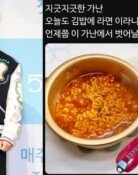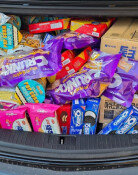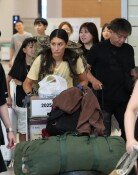Gov`t to step up war on Molotov cocktails
Gov`t to step up war on Molotov cocktails
Posted April. 03, 2001 12:55,
Increasingly violent street demonstrations involving a greater number of petrol bombs have prompted police to come up with new countermeasures.
Molotov cocktails were used in 172 demonstrations in 1997 but the frequency seemed to decrease as the government started to desist from firing tear-gas bombs at demonstrations since the incumbent administration took over in 1998. The number fell to two in 1998 and seven in both 1999 and 2000. This year, however, the first three months saw protesters throwing petrol bombs 15 times, almost matching the total over the last three years.
The number of fire bombs thrown rose sharply from 170 in 1998 to 613 in 1999, 746 in 2000 and 1672 during the first quarter of this year. In 1997, the number of bombs was a whopping 69,160.
More recently, police were alarmed by the appearance of several Websites showing methods of making new types of fire bombs that are more destructive than existing ones, such as petrol bombs containing special ingredients and employing the fuse used for firecrackers, which can blow up in midair.
On Mar. 1, demonstrators showed up in downtown Seoul with Molotov cocktails. Some 1,300 protesters consisting of college students and laid-off Daewoo Motor workers occupied the Shinchon intersection for half an hour and hurled over 50 petrol bombs. The outburst came ten months after student activists used fire bombs in front of Korea University on Labor Day last May. About 1,500 unionists and radical students in 35 separate groups, including the Korean Confederation of Trade Unions, joined in a ``people`s rally`` at Chongmyo Park in downtown Seoul. They also occupied the eight-lane avenue in front of Yonsei University and mounted a fierce protest, throwing Molotov cocktails and wielding wooden clubs and steel pipes.
The organization of a police task force to investigate fire-bomb throwers and mobile anti-petrol bomb details is part of an all-out war against illegal and violent demonstrations. National Police Commissioner Lee Moo-Young said on Mar. 3 that even though the use of tear gas would be avoided as much as possible, the police would clamp down on those who manufacture, transport and used fire bombs, arresting and meting out due penalties to offenders.
Police authorities decided to allow officers to use anti-riot gas rifles to fire rubber bullets against demonstrators using new types of fire bombs made of more explosive material. The proposed use of rubber bullets touched off debates over the danger that the bullets could cause loss of eyesight or other similar injuries.
Noting the ``highly regrettable return of petrol bombs and steel pipes`` to the scene of mass protests, President Kim Dae-Jung declared Monday that no unlawful and violent activism would be tolerated. He told the newly appointed leaders of administrative departments that no advanced nation would permit such illegal acts as throwing fire bombs, according to presidential spokesman Park Joon-Young.
Lee Pal-Ho, director of the Seoul Metropolitan Police Agency, said water cannons could be used in the event demonstrators block traffic and stage violent protests involving the throwing of Molotov cocktails. Other aides to the president at Cheong Wa Dae also said the government would deal sternly with petrol bomb-throwing demonstrators, calling them urban guerrillas.
But law-enforcement leaders are not sure to what extent these strong-arm reactions could dampen the resurgence of violent protest campaigns by discontented workers, jobless people and student radicals.
Yun Seung-Mo ysmo@donga.com







